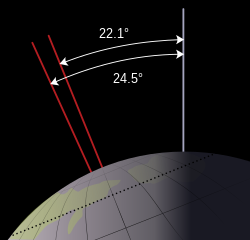100,000-year problem
The amount of incoming solar radiation, also called insolation determines the temperature on Earth. This temperature rises and falls according to the strength of radiation given off by the sun, the distance from the earth to the sun, and the tilt of the Earth's axis of rotation. However, the recent change between glacial and inter-glacial states that occurs on a circa 100,000 year (100 ka) timescale, does not correlate well with these factors. This is known as the 100,000 year problem.
Due to variations in the Earth's orbit, the amount of insolation varies; there are periods of around 21,000, 40,000, 100,000, and 400,000 years. Variations in the amount of solar energy drive changes in the climate of the Earth, and are recognised as a key factor in the timing of start and termination of glaciations. Looking at strata, isotope analysis can be performed. One of the most precise methods consist in using Oxygen-18. The amount of oxygen 18 mainly depends on the amount of ice that can be found and on the temperature of the planet.
There are different hypotheses to explain the phenomenon:
- There may be an internal frequency to the climatic system found on earth. This resonance may be 100,000 years.
- The Orbital inclination has a frequency of 100,000 years.
- The planets rotate around the sun in an elliptical orbit. These orbits change over time. For the earth, this change has a frequency of 21,636 years. In an ice age, the buildup of ice is slow, but the melting of the ice is fast.
- The luminosity of the sun may change over time. This would influence the phenomenon
- The amount of photosynthesis on water-dwelling organisms as opposed to that of land-dwelling organisms may influence the amount of Oxygen 18. This is known as the Dole effect
100,000-year Problem Media
A Template:Delta record for the past 140,000 years from Greenland (NGRIP) and Antarctica (EPICA, Vostok) ice cores
An algal bloom. The relative importance of land- and sea-based photosynthesis may fluctuate on a 100,000-year timescale.




